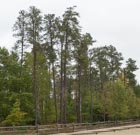
Nearly pure stand of mature trees with hardwood understory, at Pictured Rocks National Lakeshore, Michigan [C.J. Earle, 2019.10.04].

Mature forest dominated by Pinus banksiana; Gotham Pine Barrens State Natural Area, Wisconsin [C.J. Earle, 2019.10.10].

Mixed forest with mixed regeneration of P. banksiana and P. strobus, and understory of Gaylussia; Pictured Rocks National Lakeshore, Michigan [C.J. Earle, 2019.10.01].
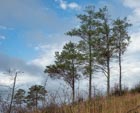
Trees at the Namekagon Barrens, Wisconsin; P. resinosa also present, visible at lower left; typical sandy, nutrient-poor site with frequent fire regime [C.J. Earle, 2019.10.01].
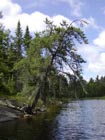
Riparian tree in Baxter State Park, Maine. About 8 m tall [C.J. Earle, 2003.07.14].
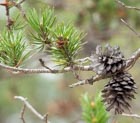
Foliage and opened cones on a tree in upper Michigan [C.J. Earle, 2019.10.04].
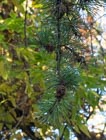
Foliage bearing clusters of several-months-old pollen cones, Kettle Moraine State Forest, Wisconsin [C.J. Earle, 2019.10.08].

Bark on a tree about 40 cm diameter, Itasca State Park, Minnesota [C.J. Earle, 2019.09.29].
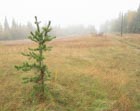
Sapling invasive in agricultural field near Itasca State Park, Minnesota [C.J. Earle, 2019.09.30].

Bog at Namekagon Barrens, Wisconsin; trees in middle ground are diminutive but cone-bearing Pinus banksiana; site also supports substantial Larix laricina and Picea mariana [C.J. Earle, 2019.10.01].

Foliage and mature but very small seed cone on one of the Namekagon Barrens bog pines [C.J. Earle, 2019.10.01].

Largest specimen I've seen, about 20 m tall and 65 cm dbh, Itasca State Park, Minnesota [C.J. Earle, 2019.09.29].

Conservation Status

Pinus banksiana
Lambert 1803
Common names
Jack pine, eastern jack pine, gray pine, black pine, blackjack pine, scrub pine, Banksian pine (Peattie 1950), pin gris [French] (Kral 1993); okikaandag, akikaandag [Ojibwe]; バンクスマツ [Japanese].
Taxonomic notes
Syn: Pinus divaricata (Aiton) Sudworth; P.sylvestris Linnaeus var. divaricata Aiton (Kral 1993).
Hybridizes with Pinus contorta subsp. latifolia in parts of western Alberta and in northeastern British Columbia; the fertile hybrid is Pinus × murraybanksiana Righter & Stockwell 1949. Although the hybrid was described on the basis of results of experimental crosses conducted in California, Critchfield (1980) described the occurrence of natural hybrids. Wood (2006) found hybrids to be common in the area around Fort Nelson, BC; the hybrids all showed P. contorta maternity and P. banksiana paternity, with physical differences in characters including needle width/length, cone angle of attachment, cone curvature, and cone length. More geographically extensive sampling of the hybrid zone has revealed that P. contorta and the hybrids grow at consistently higher elevations than the P. banksiana parents (Rweyongeza et al. 2007).
Description
"Trees to 27 m; trunk to 0.6 m diam., straight to crooked; crown becoming irregularly rounded or spreading and flattened. Bark orange- to red-brown, scaly. Branches descending to spreading-ascending, poorly self-pruning; twigs slender, orange-red to red-brown, aging gray-brown, rough. Buds ovoid, red-brown, 0.5-1 cm, resinous; scale margins nearly entire. Leaves 2 per fascicle, spreading or ascending, persisting 2-3 years, 2-5 cm x 1-1.5(2) mm, twisted, yellow-green, all surfaces with fine stomatal lines, margins finely serrulate, apex acute to short-subulate; sheath 0.3-0.6 cm, semipersistent. Pollen cones cylindric, 10-15 mm, yellow to orange-brown. Seed cones maturing in 2 years, shedding seeds soon thereafter or often long-serotinous and shedding seeds only through age or fire, upcurved, asymmetric, lanceoloid before opening, ovoid when open, 3-5.5 cm, tan to light brown or greenish yellow, slick, nearly sessile or short-stalked, most apophyses depressed but increasingly mammillate toward outer cone base; umbo central, depressed, small, sunken centrally, unarmed or with a small, reflexed apiculus. Seeds compressed-obovoid, oblique; body 4-5 mm, brown to near black; wing 10-12 mm. 2n=24. " (Kral 1993). See García Esteban et al. (2004) for a detailed characterization of the wood anatomy.
Kral (1993) states that Pinus banksiana can be distinguished from its near relative P. contorta by its seed cones, which are curved forward on branches, unarmed or with small reflexed apiculi. In P. banksiana the seed cones are spreading to recurved on branches, mostly armed with prickles. Farjon (2010) distinguishes the two species by pollen cone color (orange-red before anthesis is P. contorta vs. yellow in P. banksiana) and by details of the mature seed cone. In P. contorta it is ovoid, asymmetrical at base when closed, and the umbos bear a variable but persistent prickle. In P. banksiana the seed cones are asymmetrical, curved when closed, and serotinous, with unarmed umbos. Note that cones of subsp. latifolia are also generally serotinous; also, in my experience, the closed cones of P. banksiana have a greater length/width ratio than those of P. contorta.
Distribution and Ecology
Canada: North West Territories, British Columbia, Alberta, Saskatchewan, Manitoba, Ontario, Québec, Prince Edward Island, New Brunswick and Nova Scotia; and USA: Minnesota, Wisconsin, Michigan, Illinois, Indiana, Pennsylvania, New York, Vermont, New Hampshire, and Maine. Establishes after fire in boreal forests, tundra transition areas, dry flats and hills, and on sandy soils; at elevations of 0-800 m (Kral 1993). See also Thompson et al. (1999). Hardy to Zone 2 (cold hardiness limit between -45.6°C and -40.0°C) (Bannister and Neuner 2001).
Distribution of P. banksiana (blue) and P. contorta, based on data downloaded from GBIF on 2021.02.27, DOI: https://doi.org/10.15468/dl.yszq86 (banksiana) and DOI: https://doi.org/10.15468/dl.au4a94 (contorta).
Jack pine is a classic early-successional species, most commonly establishing in areas where mineral soil has been exposed by fire, or on similar nutrient-poor substrates such as sand barrens or recently stabilized dunes. It is a highly shade-intolerant trees; the only less tolerant conifer in its native range is Larix laricina. It is not a long-lived tree, showing signs of decadence by age 75 and commonly disappearing from the stand by the time 200 years have passed, though some trees live i]as long as 250 years. In these older stands, jack pine normally gives way to conifers such as Pinus resinosa, P. strobus, or even more shade-tolerant species such as Abies balsamea and Picea mariana (Carey 1993).
A variety of pests and pathogens afflict jack pine. Root borers, root feeders, shoot and stem borers, leaf feeders, needle miners, and sucking insects attack seedlings, while many other insects feed on the seed cones. The trees may be defoliated by the redheaded pine sawfly Neodiprion lecontei or the jack pine budworm Choristoneura pinus. Fungal diseases include the root rot Armillaria ostoyae and the pine gall rust Endocronartium harknessii (Carey 1993).
The endangered Kirtland's warbler (Dendroica kirtlandii) is dependent on sizable (larger than 80 ha) stands of young (1.5-4 m tall) P. banksiana forest for breeding habitat. The warbler became endangered due to loss of habitat as fire suppression eliminated young P. banksiana stands from the landscape, and suitable habitat is now maintained (in central lower Michigan) through an extensive controlled burning program (Mayfield 1953, Griggs 1997). Jack pine also provides food and cover for many other wildlife species; the seeds are eaten by rodents and birds, and the foliage is preferentially browsed by white-tailed deer and snowshoe hares. Woodland and barren-ground caribou eat lichens growing on the ground and on tree bark in jack pine stands (Carey 1993).
Remarkable Specimens
Currently, the largest is a specimen in St. Louis County, Minnesota, measured in 2018 at 66 cm dbh and 22.2 m tall (American Forests 2021). Larger trees have been measured; in 1996 the champion was a tree 94 cm dbh in Lake Bronson, Minnesota (American Forests 1996). An interesting example of an early "big tree" discussion appears in this short piece (accessed 2023.03.11) by a young C. Hart Merriam in 1895.
The oldest known living specimen, 327 years, was documented in a tree-ring chronology covering the period 1679-2005 (crossdated after 1832), collected just north of Yellowknife, Northwest Territories, Canada by Sonia St-Onge, Michael Pisaric, and Steve Kokelj (doi.org/10.25921/v3tn-6251). Site notes record "there was little to no soil cover and ground cover was predominantly
mosses and lichens". This site was used in a dendroclimatic reconstruction (Pisaric et al. 2009). There is also a crossdated age of 246 years for a tree near Blue Lake, Ontario (Girardin et al. 2006).
Ethnobotany
This is an important commercial timber species in the United States and Canada. The moderately hard and heavy wood is used for pulp, lumber, poles, fence posts, mine timbers, railroad ties, and Christmas trees. It is also planted, although with varying success, for rehabilitation of waste lands such as coal mining areas and mined areas in the Alberta tar sands region (Carey 1993). It is even sometimes planted as an ornamental species, though most horticulturalists seem to find it unlovely, describing it as "crooked", "scrawny," "scrubby," or even "starving."
Observations
Very common and widely-distributed, this species is not difficult to find within its native range. The locations named in the photographs are all worth a visit.
Remarks
This species was named in honor of Sir Joseph Banks (1743-1820), president of the Royal Society from 1778 until 1819, and in consequence probably the most influential scientist of his day.
This is one of the most cold-hardy trees known; specimens prehardened to subfreezing temperatures showed no adverse effects from immersion in liquid nitrogen (-196°C) (Sakai and Weiser 1973).
Jack pine is the territorial tree of the North West Territories (Kral 1993).
This tree forms the subject of one of the most celebrated paintings by a Canadian artist, "The Jack Pine” by Tom Thomson of the Group of Seven.
Citations
American Forests 1996. The 1996-1997 National Register of Big Trees. Washington, DC: American Forests.
Critchfield, W. B. 1980. Genetics of lodgepole pine. Research Paper WO-37. Washington, DC: USDA Forest Service. 57 p.
Girardin, M.-P., J. C. Tardif, M. D. Flannigan and Y. Bergeron. 2006. Synoptic-Scale Atmospheric Circulation and Boreal Canada Summer Drought Variability of the Past Three Centuries. Journal of Climate 19(10):1922-1947.
Griggs, Jack L. 1997. All the birds of North America. New York: Harper Collins.
Lambert, A. B. 1803. A description of the genus Pinus, illustrated with figures, directions relative to the cultivation, and remarks on the uses of the several species. London: J. White.
Mayfield, H. F. 1953. A census of the Kirtland's warbler. The Auk 70: 17-20 (cited in Burns and Honkala 1990).
Pisaric, Michael F. J., Sonia M. St-Onge, and Steven V. Kokelj. 2009. Tree-ring reconstruction of early-growing season precipitation from Yellowknife, Northwest Territories, Canada. Arctic, Antarctic, and Alpine Research 41(4):486-496.
Righter, F. I. and Palmer Stockwell. 1949. The fertile species hybrid, Pinus murraybanksiana. Madroño 10(3):65-70. Available: Biodiversity Heritage Library, accessed 2021.12.19.
Rweyongeza, D.M., Dhir, N.K., Barnhardt, L.K., Hansen, C. and Yang, R.C. 2007. Population differentiation of the lodgepole pine (Pinus contorta) and jack pine (Pinus banksiana) complex in Alberta: growth, survival, and responses to climate. Canadian Journal of Botany 85(6):545-556.
Sakai, A. and C. J. Weiser. 1973. Freezing resistance of trees in North America with reference to tree regions. Ecology 54:118–126.
Wood, Lisa. 2006. An investigation of natural hybridization between jack pine (Pinus banksiana) and lodgepole pine (Pinus contorta var. latifolia) in northern British Columbia. M.S. Thesis, University of Northern British Columbia.
See also
Elwes and Henry 1906-1913 at the Biodiversity Heritage Library. This series of volumes, privately printed, provides some of the most engaging descriptions of conifers ever published. Although they only treat species cultivated in the U.K. and Ireland, and the taxonomy is a bit dated, still these accounts are thorough, treating such topics as species description, range, varieties, exceptionally old or tall specimens, remarkable trees, and cultivation. Despite being over a century old, they are generally accurate, and are illustrated with some remarkable photographs and lithographs.












